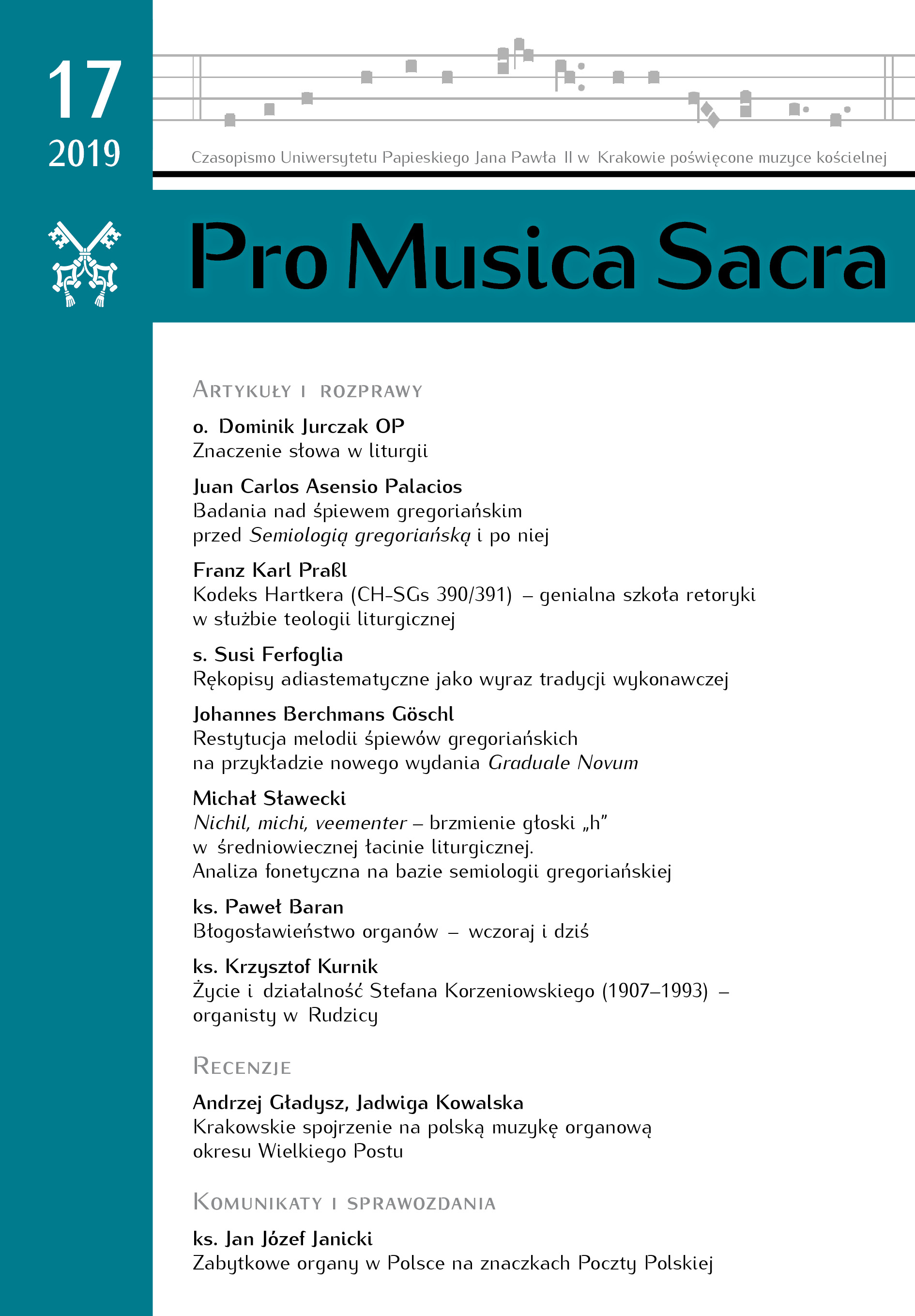Kodeks Hartkera (CH-SGs 390/391) – genialna szkoła retoryki w służbie teologii liturgicznej
DOI:
https://doi.org/10.15633/pms.3491Słowa kluczowe:
kantylacja, muzyczna interpretacja biblijnych tekstów, Sankt Gallen, retoryka, Hartker, antyfonarz, teologia liturgiczna, aggiornamentoAbstrakt
Muzyka liturgiczna w pierwszym tysiącleciu była przede wszystkim kantylacją; kantor
recytował teksty liturgiczne formułami i frazami muzycznymi, aby wyrazić strukturę
i znaczenie tekstu. Za pomocą języka mówionego kantor musiał podać wszystkie informacje
dotyczące czytania lub modlitwy. Dla dobrej recytacji potrzeba dwóch elementów:
akcentu i artykulacji. Wszystkie rodzaje kadencji są akustycznymi znakami interpunkcyjnymi.
Najstarsze neumy musiały służyć tym regułom języka. Zgodnie z tradycją,
mnich Hartker był pisarzem znanego antyfonarza z około roku 1000. W rzeczywistości
ten rękopis miał czterech głównych skrybów, a może jeszcze wiele innych dodatkowych.
Wszyscy postępowali zgodnie z zasadą wyrażania teologii liturgicznej za pomocą muzyki,
takiej jak akcent i artykulacja. Przedstawione przykłady pokazują, w jaki sposób notatorzy
rozumieli teksty, których słowa w antyfonie służyły jako słowa kluczowe, które aspekty
teologiczne były dla nich ważne. Jest to szkoła modlitwy zgodnie z zasadą logiké latreia, według której, człowiek się modli intelektem, duchem i emocjami. Hartker jest jakby aggiornamento Biblii w X wieku.
Bibliografia
Abbatia Sanctae Mariae de Pratalea, Liber Antiphonarius pro diurnis horis Liturgiae horarum monasticae schema B, t. 1, De Tempore, Teolo 2017.
Agustoni L., Göschl J. B., Einführung in die Interpretation des Gregorianischen Chorals, t. 1, Regensburg 1987, s. 97–134.
Angenendt A., Geschichte der Religiosität im Mittelalter, Darmstadt 1997.
Antiphonae et Responsoria pro diurnis horis restituta et ornata neumis Sangallensibus praesertim
Antiphonarii 390–391, quod dicitur, Hartkerii. (Liturgia Horarum secundum Ordinem
Cantus Officii anno MMXV a Sacra Congregatione de Cultu Divino et Disciplina
Sacramentorum editum), t. 1, Tempus Adventus et Nativitatis, t. 2, Tempus Quadragesimae,
Sacrum Triduum Paschale, Tempus Paschale, Verona 2016–2017.
Antiphonale Monasticum [= Liber Antiphonarius pro diurnis Horis], t. 1–3, Solesmes
–2007.
Boethius, De institutione arithmetica libri duo, De institutione musica libri quinque, ed.
G. Friedlein, Leipzig 1867.
Cantor and Cantorial music. The New Encyclopedia of Judaism, ed. G. Wigoder, F. Skolnik,
S. Himelstein, New York 2002.
Dobszay L., Tätigkeitsbereich und Ausbildung – historische Modelle des Kirchenmusikerberufes,
„Singende Kirche” 54 (2007), s. 14–18.
Franz A., Die Tagzeitenliturgie der Mailänder Kirche im 4. Jahrhundert. Ein Beitrag zur
Geschichte des Kathedraloffiziums im Westen, „ALw” 34 (1992), s. 23–83.
Graduale Novum, editio magis critica iuxta SC 117, t. 1, De Dominicis et Festis, t. 2. De
Feriis et Sanctis, Regensburg 2011–2018.
Hiley D., Western Plainchant. A Handbook, Oxford 1993, s. 46–68, www.epub.uni-regensburg.
de/25558/1/ubr12760_ocr.pdf (20.11.2018).
Kurzschenkel W., Die theologische Bestimmung der Musik, Trier 1971.
Medieval Cantors and Their Craft. Music, Liturgy and the Shaping of History, ed. K. A.-M.
Bugyis, A. B. Kraebel, Margot Fassler, York 2017, s. 800–1500.
Pouderoijen K., de Loos I., Wer ist Hartker? Die Entstehung des Hartkerischen Antiphonars,
„BzG” 47(2007), s. 67–86.
Praßl F. K., Muss Hartker Vergleiche fürchten? Zur Notation einer Sammelhandschrift des 10.
Jh. aus St. Alban, Mainz, heute Wien ÖNB codex latinus 1888, „BzG 59/60” (2015),
s. 203–219.
Praßl F. K., Scriptor Interpres. Von Neumenschreibern und ihren Eigenheiten „BzG” 37 (2004),
s. 55–72, 60–61.
Rankin S., Vor Sankt Gallen: Klänge einfangen – Notationen gestalten – Musik aufschreiben
zwischen 800 und 900, BzG 65/66 (2018), s. 47–68, 64n.
Schmid B., Deutscher Liturgiegesang, w: Musik im Gottesdienst, ed. H. Musch, t. 1, Regensburg
, s. 357–520, 403.
Totzke I., Dir singen wir. Beiträge zur Musik der Ostkirche, St. Ottilien 1992.
Źródła internetowe
www.e-codices.unifr.ch/de/list/csg/Shelfmark (30.11.2018).
Pobrania
Opublikowane
Numer
Dział
Licencja
Autorzy publikujący w czasopiśmie udzielają jego wydawcy zgody o następującej treści:
- Autor zachowuje autorskie prawa majątkowe do utworu, a jednocześnie udziela wydawcy czasopisma zgody na jego pierwszą publikację w wersji drukowanej i wersji online na licencji Creative Commons Uznanie autorstwa 4.0 Międzynarodowe oraz zgody na wykonywanie opracowań, w tym przekładów.
- Autor ma możliwość udzielania zgody niewyłącznej na opublikowanie utworu w wersji, która ukazała się w czasopiśmie (np. zamieszczenia go w repozytorium instytucjonalnym lub opublikowania w książce), wraz z informacją o jego pierwszej publikacji w czasopiśmie.
- Autor może umieścić swój utwór online (np. w repozytorium instytucjonalnym lub na swojej stronie internetowej) jeszcze przed zgłoszeniem utworu do czasopisma.

